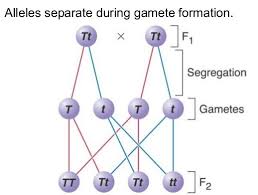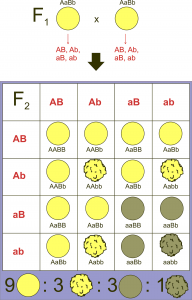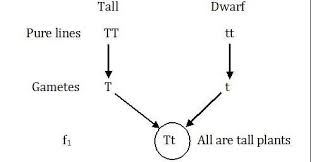MENDEL’S LAW OF INHERITANCE
INTRODUCTION
Mendelian inheritance describes the type of biological inheritance proposed by Gregor Mendel in 1865 and 1866, re-discovered in 1900 by three European scientist Hugo de Vries, Carl Correns & Erich Von Tschermak. After that, three fundamental principles were universally accepted known as law of inheritance.
HISTORY
History of Mendelian inheritance is summarized here:
- Between 1856 and 1863, Mendel cultivated and tested some 5,000 pea plants in the garden of his monastery.
- From these experiments, he induced two generalizations which later became known as Mendelian inheritance.
- He described his experiments in a two-part paper entitled “Experiments on Plant Hybridization” that he presented to the Natural History Society of Brno on 8 February and 8 March 1865, but published in 1866.
- Though Mendel’s findings were largely ignored by the vast majority due to wide acceptability of Darwin’s theory of continuous variation, unknown chromosomal behavior and phenomenon of fertilization, and some mathematical calculation and probability law.
- In 1900, however, his work was “re-discovered” by three European scientists individually, Hugo de Vries, Carl Correns, and Erich Von Tschermak. Still the findings were controversial because many were not sure whether it would be applied on all species or not, until popularized by William Bateson who also coined the term genetics and allele.
- Later work by biologists and statisticians such as Ronald Fisher showed that if multiple Mendelian factors were involved in the expression of an individual trait, they could produce the diverse results observed, and thus showed that Mendelian genetics is compatible with natural selection.
- Thomas Hunt Morgan and his assistants integrated Mendel’s theoretical model with the chromosome theory of inheritance, in which the chromosomes of cells were supposed to hold the actual hereditary material, and proposed the classical genetics, a highly successful foundation which eventually cemented Mendel’s place in history.
MENDEL’S LAWS
- Law of Segregation
- During gamete formation, the alleles (Dominant and Recessive) for each gene segregate or separate from each other so that each gamete carries only one allele for each gene.
While in heterozygous state, the dominant and recessive allele remains together throughout the life without mixing with each other. Hence this law is also known as purity of gametes. - The Law of Segregation of genes applies when two individuals, both heterozygous for a certain trait are crossed, for example hybrids of the F1-generation.
- The offspring in the F2-generation differ in genotype and phenotype, so that the characteristics of the grandparents regularly occur again.
- In a dominant-recessive inheritance an average of 25 % are homozygous with the dominant trait, 50 % are heterozygous showing the dominant trait in the phenotype, 25 % are homozygous with the recessive trait and therefore express the recessive trait in the phenotype.
- This results genotypic ratio of 1: 2: 1, and the phenotypic ratio of 3: 1.

2. Law of Independent Assortment
- This law states that segregation and assortment of alleles for different characters are independent to each other.
- However this principle is applicable on the alleles of genes located on the different chromosomes but not to the linked genes. Mendel found support for this law in his dihybrid cross experiments.
- In his monohybrid crosses, an idealized 3:1 ratio between dominant and recessive phenotypes resulted.
- In dihybrid crosses, however, he found a 9:3:3:1 ratios. This shows that each of the two alleles is inherited independently from the other, with a 3:1 phenotypic ratio for each.
Independent assortment occurs in eukaryotic organisms during meiotic metaphase I, and produces a gamete with a mixture of the organism’s chromosomes. Along with crossing over, independent assortment increases genetic diversity by producing novel genetic combinations.

3. Law of Dominance
- The Law of Dominance states that when an organism is heterozygous for a trait (means it has two different alleles for that gene), the allele that is expressed is the dominant.
- It means F1 individual derived from crosses between two homozygous parents, having different characters shows only one of traits that are called dominant and the other which does not appear in F1 generation but reappeared in F2 generation is called recessive. So the hybrid of F1 generation always is uniform and that’s why law of dominance is also named as law of uniformity of first filial generation.
- But for some characteristics, the F1 hybrids have an appearance in between the phenotypes of the two parental varieties. For example, A cross between two four o’clock (Mirabilis jalapa) plants shows an exception to Mendel’s principle, called incomplete dominance.

(Image courtesy)
FAQ (Frequently Asked Question)
What are the three laws of inheritance proposed by Mendel?
These are:
- Law of Dominance
- Law of Segregation
- Law of Independent Assortment
Which is the universally accepted law of inheritance proposed by Mendel?
Law of segregation. During gamete formation, the alleles (Dominant and Recessive) for each gene segregate from each other so that each gamete carries only one allele for each gene. While in heterozygous state, the dominant and recessive allele remains together throughout the life without mixing with each other. Hence this law is also known as purity of gametes.
Why did Mendel choose pea plants for his experiments?
Mendel chooses pea plants for his experiments because of the following reasons:
- The flowers of this plant are bisexual.
- Pea plants are self-pollinated, and thus, self and cross-pollination can easily be performed.
- The different physical characteristics were easy to recognize and study.
- They have a shorter life span hence were easy to maintain and record.
Mendel’s findings were rediscovered by?
In 1900, his work was “re-discovered” by three European scientists individually, Hugo de Vries, Carl Correns, and Erich von Tschermak.
Read more..
MITOSIS & MEIOSIS- CELL DIVISION
CROSSING OVER- PROCESS & FUNCTION
LINKAGE AND CROSSING OVER-AN OVERVIEW
HOMOLOGOUS CHROMOSOMES-AN OVERVIEW & FUNCTION
DIFFERENCE BETWEEN GENE AND ALLELE
WHAT BIODIVERSITY IS-MEANING,TYPES&THREATS
IMPORTANCE OF BIODIVERSITY
BIODIVERSITY HOTSPOTS IN INDIA